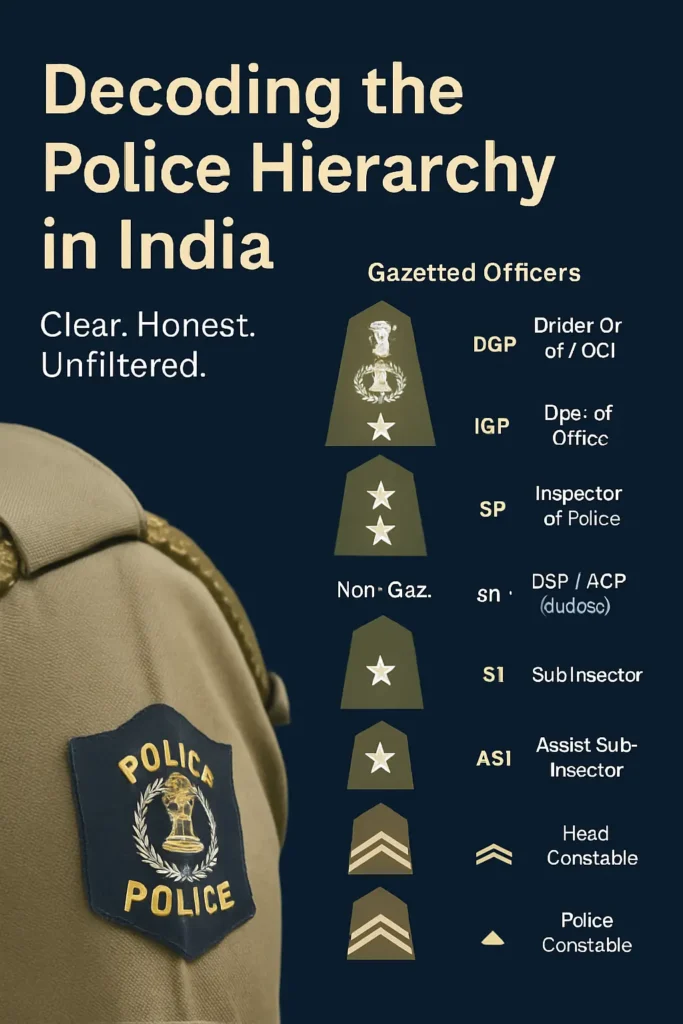Let’s not sugarcoat it —
When a police officer stops you, the badge on their shoulder isn’t just a piece of cloth.
It’s power.
And power in India comes with rank, authority, and hierarchy.
But here’s the thing:
Most citizens (and honestly, even many law students) don’t know the actual structure behind those stars and stripes.
So today, we’re decoding the entire police hierarchy in India — not in boring government lingo, but in your language.
Clear. Honest. Unfiltered.
FIRST: WHY THIS MATTERS
Because badges command behaviour.
Ever seen someone’s tone change when they realise the cop in front of them is an IPS officer?
Or watched how junior constables literally snap to attention when a DCP walks in?
That’s hierarchy in action.
And if you want to understand power, policing, or even fight police abuse someday as a lawyer —
you need to know who’s who in khaki.
THE BIG PICTURE: TWO TYPES OF POLICE OFFICERS
India’s police force is divided into two broad categories:
- Gazetted Officers (Officers)
- These are senior-level officers.
- Directly appointed by the State Public Service Commission or UPSC (for IPS).
- They have administrative powers and often command entire districts or zones.
- Non-Gazetted Officers (Subordinates)
- Includes constables, head constables, and sub-inspectors.
- Field-level execution of duties.
- Often the first responders in any law and order situation.
Let’s go deeper into the hierarchy now — top to bottom.
TOP-TIER: INDIAN POLICE SERVICE (IPS) CADRE
This is where real authority begins.
That badge?
Ashoka emblem. Sword. Baton.
It’s not design — it’s dominance.
A DGP doesn’t chase criminals.
They control the people who do.
Transfers. Orders. Law & order across the entire state — all in their hands.
When that badge walks in,
every cop stands straight.
Because in this game, rank is law.
No stars? You follow.
Sword & baton? You lead.
That’s how the system works.
Simple. Ruthless. Real.

1. Director General of Police (DGP)
- Badge: National emblem + crossed sword and baton
- Position: Head of the entire state police force.
- Reports directly to the Chief Minister.
- Deals with: state-wide law & order, transfers, overall administration.
Reality check: A DGP rarely hits the streets — but every cop answers to him/her.
2. Additional Director General of Police (ADGP)
- Badge: Same as DGP but slightly lower in command.
- Usually in charge of specialised departments like law & order, intelligence, prisons, etc.
- Coordinates with Central forces and intelligence wings.
3. Inspector General of Police (IGP)
- Badge: National emblem + two stars
- Supervises several police ranges or zones.
- Acts as a bridge between field officers and state headquarters.
4. Deputy Inspector General of Police (DIG)
- Badge: National emblem + one star
- Supervises a group of districts.
- Ensures command discipline among SPs and lower officers.
5. Superintendent of Police (SP)
- Badge: National emblem only
- In charge of a district — the face of policing in that region.
- Coordinates with the District Magistrate.
- Handles everything from riots to VIP movements.
MIDDLE-TIER: THE CORE OF DISTRICT POLICING
6. Additional Superintendent of Police (Addl. SP)
- Badge: Three stars
- Assists the SP in running district affairs.
- Often manages rural zones within the district.
7. Deputy Superintendent of Police (DSP) / Assistant Commissioner of Police (ACP)
- Badge: Three stars
- Called ACP in commissionerates (like Mumbai, Delhi).
- First gazetted rank — typically the first stop for UPSC/State PCS officers.
FRONTLINE FIELD OFFICERS
8. Inspector of Police
- Badge: Three stars
- In charge of a police station in big cities or subdivisions.
- Handles criminal investigations, FIRs, arrests, and court work.
- Can conduct inquiries and supervise sub-inspectors.
9. Sub-Inspector of Police (SI)
- Badge: Two stars
- First rank allowed to file a charge sheet in court.
- Investigates cases, records FIRs, arrests suspects.
- Often the backbone of small-town or rural police stations.
10. Assistant Sub-Inspector (ASI)
- Badge: One star
- Assists SIs in investigation and station work.
- Cannot register FIRs on their own.
THE GROUND WORKFORCE
11. Head Constable
- Badge: Three chevrons
- Senior to constables, handles some paperwork, assists in field ops.
12. Police Constable
- Badge: No stars — just the shoulder strap with state police symbol
- The first responder.
- Most visible, most abused, and often most overworked.
- Often suffers poor pay, harsh working hours, and transfers.
QUICK BADGE GUIDE (VISUAL SUMMARY)
| Rank | Badge Symbol |
|---|---|
| DGP | National Emblem + Sword & Baton |
| ADGP | National Emblem + Sword & Baton |
| IGP | National Emblem + 2 Stars |
| DIG | National Emblem + 1 Star |
| SP | National Emblem |
| Addl. SP / ACP / DSP | 3 Stars |
| Inspector | 3 Stars |
| Sub-Inspector | 2 Stars |
| ASI | 1 Star |
| Head Constable | 3 Chevrons |
| Constable | None |
THE TRUTH BEHIND THE UNIFORM
Let’s face it:
The higher the rank, the more the respect — and sometimes, the more the fear.
But also — the more political pressure, responsibility, and moral duty.
Police hierarchy in India isn’t just structure.
It’s a mirror of how power flows, how justice moves, and how citizens get treated.
So the next time someone flashes a badge —
Don’t just look at the stars.
Look at what they stand for:
Power, accountability, and the duty to serve — not rule.
FAQs (The Real Ones)
Q: Who is more powerful — SP or DSP?
🅰️ SP is higher than DSP. DSP reports to the SP in the district chain.
Q: Can a DSP become an IPS officer?
🅰️ Yes. Through promotion + clearing the required years of service.
Q: Can a constable become a DSP?
🅰️ Yes — but it takes years, clean service, and multiple promotions.
Q: How to identify an IPS officer by badge?
🅰️ Look for the Ashoka Emblem + sword & baton symbol. That’s top-tier IPS.




